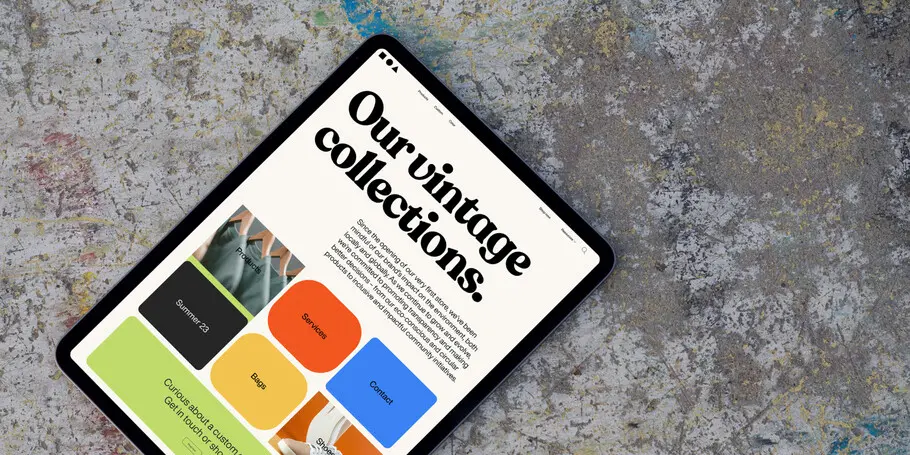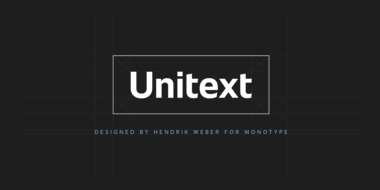No fuzzy business: 5 ways to keep your brand thriving in a digital age.

Can your brand fonts transition seamlessly from brick & mortar to the web? Are your fonts legible in an app? What about digital display ads or banners? How about a new environment, such as the metaverse, for that matter?
Making a brand’s omni-channel presence and digital transformation cohesive across all platforms is no small task, whether you’re producing a web page, digital banner ad, an app, VR experience, or new game in a virtual arena.
As consumers hop from big screens to little screens and back again, it’s crucial for brands to keep up. Font choice plays a major role. After all, a consistent brand presence across any and every touchpoint keeps the trust level high, and creates an enjoyable customer experience.
So, the next time you find yourself designing for the modern world, use this handy checklist to ensure your fonts are on par with the digital age—with no fuzzy business.
1. Check: Is it legible?
If a designer finds a font that’s perfectly legible on one device, it might not always be the case for another. Annoying? Yes. Solvable? Also yes. Using a font that’s native to an app, or adjusting the spacing character by character until it looks just right in your design application can still lead to fuzziness, imprecision, or even mistrust of the brand. Consumers should easily be able to read fonts in the digital world, whether that’s on an app, in a video game, or in a VR landscape. Choosing a typeface that’s expertly designed to work in all of these formats is key.
2. Check: Loading speed.
As brands connect with customers in the digital landscape, there’s a functional aspect to consider: how is that free typeface you randomly found online affecting your load times? If you’re dealing with old font files, which may very well be the case, it’s likely having a negative impact.
Customers have no time to wait, and will exit a webpage, switch to a new app, or quit a video game if it takes too long to load. To avoid this, find fonts from sources that optimize the performance of their font software. When your fonts are always fresh from a tech perspective, you’ll never have to worry about what’s lying beneath the surface.
3. Check: Sizing up (or down).
From headlines on a website, to the text on a smartwatch’s tiny screen, using dynamic text – that is, text that changes on the layout or parameters– should be a given for any brand’s digital experience. We’ve already seen this become commonplace in Web 2, as many dynamic websites easily scale from desktop, to tablet, to mobile. Now, brands will have to think about how their fonts appear in more collaborative, decentralized landscapes, like Web 3, as well as AR and VR spaces.
Finally, if there’s a change in a message or concept, a designer (or other trusted creative) must be able to make that text change quickly. This happens all the time on news websites, game updates, or even retail outlets as they prepare for the season. Not much in the online space is static anymore, and having a dynamic font means making efficient, agile changes without worrying about an illegible display.
4. Check: Rendering issues.
Another font functionality tip that can’t be overlooked: text rendering. It’s complicated, especially when it comes to app development, or creating other digital assets that might have nuanced characters. Rendering issues pop up when capitalization is off, characters re-order, have an incorrect shape, or directionality. This can get particularly challenging with fonts in different languages. Smart designers can tell when rendering is off, pixelated fonts or unsophisticated layouts are a major no-go for a brand, and customers often wonder what’s making their head hurt. Choosing a trusted font with a complete set of characters and built-out scripts that render with no issues is the goal.
5. Check: Branding.
So far, we’ve covered functional and creative points that make for clear, legible, fast-loading text on all devices. Ultimately, this all adds up to brand representation. When a font that’s available in print is not optimized as a web font, designers have to make a hard choice with a web font that’s not quite up to par. Sometimes they can get away with it, and other times, it’s a mess. An inconsistent brand experience, from physical to digital, creates a sort of Uncanny Valley effect in a consumer’s mind: it subconsciously (sometimes consciously) brews mistrust, or a feeling of less empathy, or relatability to the brand.
Brands can avoid this problem by choosing a font that performs identically across physical and digital environments in the first place, especially knowing that we’re diving headfirst into a mixed reality-future (metaverse, we’re looking at you.) Bottom line? Your job as a designer is to aim for no breaks in the brand experience: and fonts play a critical role.
The fairy godmother of font selection.
Ahh… if only a fairy godmother could snap his or her fingers, and poof! These problems would go away. Sadly, that’s not the case.
The fastest way to ensure your fonts don’t fall into any of the above traps is by having a plan. Staying organized, meticulous, and having the right set of tools on hand for typeface selection is key. Unfortunately, even a couple of projects on deck can make this task seem overwhelming. Taking time away from the creative steps of the creative process is a bummer—who wants to focus on admin work when there’s fun to be had designing?
The good news is that there are typeface platforms and tools that do all the hard work for you, like Monotype Fonts. Monotype Fonts combines a comprehensive library of over 150,000 fonts, type designer and font engineering expertise along with font management tools for your brand’s creative expression. Every typeface found within Monotype Fonts is guaranteed to work perfectly in a digital world. Monotype Fonts takes care of pretty much everything. Legible fonts? Check. Dynamic fonts? Check. Rendering? It’s pristine, every time.
From a functionality standpoint, Monotype Fonts is always up-to-date with the latest files and formats: One click is all it takes to sync a typeface to your machine, and start mocking up your design concepts. Fonts downloaded from other sources can seamlessly flow into the platform, giving you and your creative team a safe space to enjoy all your fonts, and easily find them without wondering if “they’re OK to use.” (We’ve all been there.) A system like Monotype Fonts is especially helpful for organizations or agencies managing multiple brands and projects at once.
With a program like this, you can throw a checklist like this out the window. (Well, maybe not just yet.) But it sure sounds like a wish come true. In the meantime, here is a condensed version of what to check for font-wise below. To learn more about Monotype Fonts, see it in action at Monotype.com.
Font checklist for digital products.
- Legible
- Instant Loading
- Dynamic
- Pristine Pixelation
- Fits with Brand














